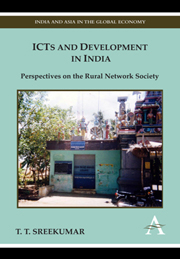Book contents
- Frontmatter
- Contents
- List of Figures and Tables
- Preface
- 1 Introduction: Exploring the Rural Network Society
- 2 Civil Society and Cyber–Libertarian Developmentalism
- 3 Decrypting E-Governance
- 4 Cyber-Kiosks and Dilemmas of Social Inclusion
- 5 Innovating for the Rural Network Society
- 6 ICT and Development: Critical Issues
- Notes
- Bibliography
- Index
5 - Innovating for the Rural Network Society
Published online by Cambridge University Press: 05 March 2012
- Frontmatter
- Contents
- List of Figures and Tables
- Preface
- 1 Introduction: Exploring the Rural Network Society
- 2 Civil Society and Cyber–Libertarian Developmentalism
- 3 Decrypting E-Governance
- 4 Cyber-Kiosks and Dilemmas of Social Inclusion
- 5 Innovating for the Rural Network Society
- 6 ICT and Development: Critical Issues
- Notes
- Bibliography
- Index
Summary
The Appropriate Technology for the Masses
One of the important questions that CSOs attempting to play a pivotal role in moulding a rural network society had to address was that of technology innovation. There were at least two major questions that they needed to answer in this domain. The first was the way in which existing technology could be adapted for the rural environment. The second was with respect to the need for promoting a series of inventions and innovations wherever the existing technological mix was found to be inadequate to launch the carefully planned ICT projects. However, the powerful and pervasive discourse on the use of ICTs that captured the imagination of a wide spectrum of academics, technicians, CSO activists and development practitioners in India, was not followed up with adequate coordinated efforts to understand the needs of each community and to evolve suitable technological packages that attended to their specific requirements. Nevertheless, many organizations and ‘social venture capitalists’ realized the need for developing appropriate technology for rural masses to get inroads into the markets at the ‘bottom of the pyramid’ (BoP). It was believed that the social bottlenecks in reaching the poorest of the consumers could be addressed by the developing imaginative and cost-effective ICT innovations.
The ICT-based activities of CSOs were characterized by a focus on providing individuals direct access to technology, and the protocols of their delivery mechanisms were dominated by a high level of technology applications.
- Type
- Chapter
- Information
- ICTs and Development in IndiaPerspectives on the Rural Network Society, pp. 125 - 150Publisher: Anthem PressPrint publication year: 2011



